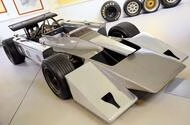The Legacy of Cosworth: A Unique Chapter in Formula 1 History
Cosworth is a name synonymous with success in the world of Formula 1, particularly during the late 1960s and 1970s. The company, initially a small engineering firm, revolutionized the sport with its DFV V8 engine, which dominated the racing scene for over a decade. However, what many fans may not know is that Cosworth also ventured into the realm of car design, creating its own unconventional F1 car that showcased innovative engineering and a bold vision for the future of racing.
The Origins of Cosworth’s Ambition
Founded by Mike Costin and Keith Duckworth, both of whom had backgrounds as engineers at Lotus, Cosworth’s rise to prominence began with the DFV engine, which was funded by Ford. This engine not only powered numerous championship-winning cars but also became a symbol of British engineering prowess. The story of Cosworth, however, is not just about engines; it also encompasses a daring attempt to design a race car that would challenge the norms of Formula 1.
In July 1969, Cosworth unveiled its unnamed F1 car, which was the brainchild of Costin, Duckworth, and Robin Herd, a design engineer who had previously worked on the Concorde project. The car was described as “something entirely new in single-seater aerodynamics, structure, and the detail arrangement of the transmission.” This ambitious project aimed to harness the power of four-wheel drive (4WD), a concept that had been explored in the sport but had yet to be fully realized.
The Promise of Four-Wheel Drive
The potential of 4WD in Formula 1 was not a new idea. As early as 1961, Stirling Moss had demonstrated the advantages of a 4WD system in a non-championship race, showcasing its ability to manage the immense power of F1 engines, which had surpassed 400 bhp. The introduction of 4WD was seen as a solution to the challenges of traction and control, particularly as cars became faster and more powerful.
Lotus had made strides in this area, nearly winning the 1969 Indianapolis 500 with a gas-turbine 4WD car. Drivers like Jackie Stewart praised the benefits of 4WD, noting that it allowed for better balance and quicker cornering, ultimately leading to faster straight-line speeds. With such promising feedback, it was clear that 4WD could revolutionize the dynamics of racing.
Cosworth’s Unique Approach to 4WD
While other teams like BRM, Lotus, and Matra integrated existing 4WD systems into their designs, Cosworth took a different route. The company developed its own innovative system, which featured a two-shaft gearbox and a unique torque-split ratio of approximately 40:60 between the front and rear wheels. This design allowed for adjustments by changing the diameters of the front and rear wheels, providing a level of customization that was unprecedented at the time.
The engineering behind the Cosworth 4WD car was intricate. The layout of the drive system was designed to eliminate unnecessary components, such as idler wheels, which were common in other designs. This streamlined approach not only reduced weight but also enhanced efficiency, showcasing Cosworth’s commitment to pushing the boundaries of automotive engineering.
Challenges and Setbacks
Despite its innovative design, the Cosworth 4WD car faced significant challenges on the track. Other teams experimenting with 4WD, such as Lotus and Matra, encountered difficulties that led to negative feedback from drivers. Jochen Rindt, a leading driver for Lotus, famously refused to race the 4WD 63 due to his discomfort with its handling. Similarly, Bruce McLaren described his experience with the M9A as akin to “signing your name with someone pushing your hand along,” highlighting the struggles drivers faced with these new technologies.
Ultimately, the Cosworth 4WD contender never made it to a race grid. By August 1969, it was concluded that “4WD in F1 has been something of an anti-climax.” The complexities of integrating 4WD into the high-speed, high-stakes environment of Formula 1 proved too daunting, and the concept was largely abandoned, with only a single experimental appearance by Lotus in 1971.
The Enduring Impact of Cosworth’s Vision
While the Cosworth 4WD car never achieved the success its creators envisioned, its legacy endures as a testament to innovation and ambition in motorsport. The story of Cosworth reflects the spirit of engineering excellence that has characterized Formula 1 for decades. It serves as a reminder that the pursuit of technological advancement often involves risks and setbacks, but it is through these challenges that the sport continues to evolve.
As we look back on this unique chapter in Formula 1 history, it is essential to recognize the contributions of Cosworth not only as an engine manufacturer but also as a pioneer in race car design. Their efforts to explore the potential of four-wheel drive may not have changed the course of racing, but they certainly added depth to the narrative of innovation in motorsport.

